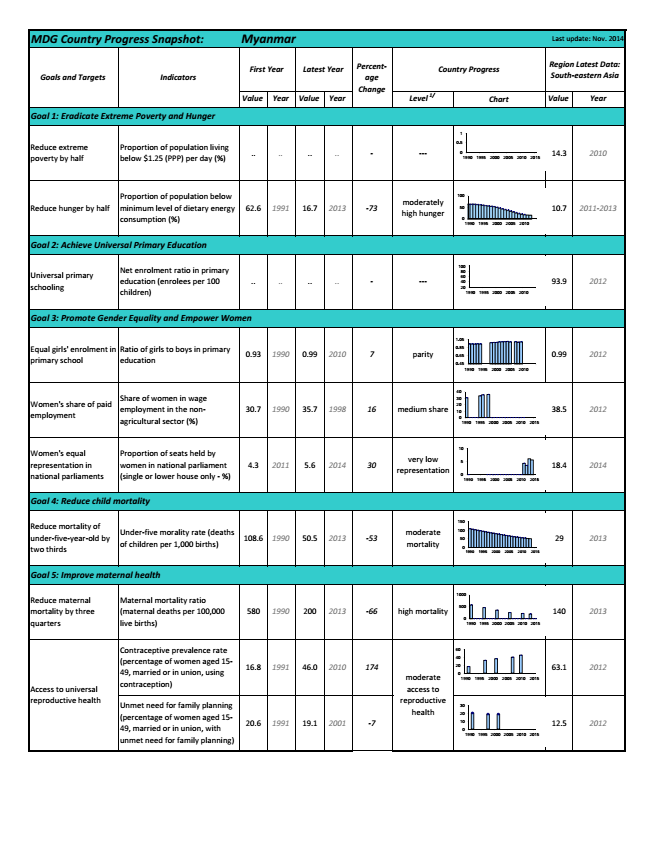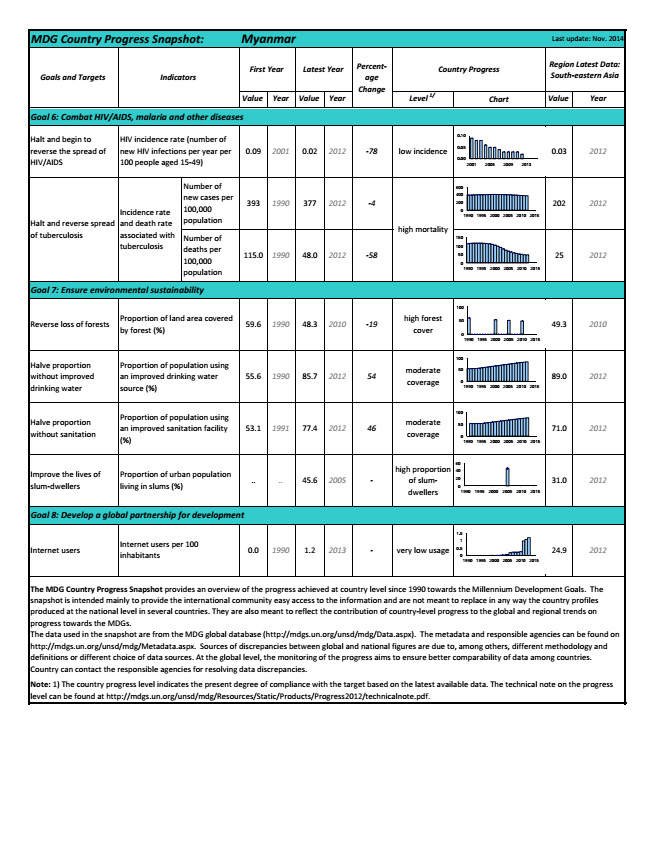I remember an interesting heading of a newspaper article
that appeared in the government-owned The
Working People's Daily (English) a long time ago in Yangon. Presently
fascinated with little data and beginning to run out of ideas, I tried adding "little
data" and "(data)" in that heading to see how it would come out.
Now inspired, I begin to see that an absence of data makes the situation a little bit tricky though it
doesn't translates to no unemployment or no disease or no illiteracy or no
depletion of resources or no hunger or no poverty, for example. Neither could
you feel defeated and assume they existed and at an alarming scale. If you
don't have data to guide you, you could be led to follow a false trail, either an
optimistic one or a pessimistic one, and get lost.
And there are many pitfalls with the data, like thinking big data = all data. In little data it is a sin to ignore the missing data. There are two kinds. When
you can't get data from some units in the sample, it is called "unit
non-response". When values are missing certain variables you are
collecting they are "item non-response". Statisticians warn that if
you couldn't get data from a significant number of households, for example, you
can't simply report the results from the households from which you have data as
if data came from the complete sample. Similarly with the missing values like
age, weight or height of children, for example.
When you ignore the missing households and just simply use the
data you have, it means you are assuming that the data from the missing
households won't be different from those you get the data. More often than not,
when you can't locate the households or the eligible respondents, or they were
not at home, or they even refused to answer then there is some reasons behind that
make them different from other households that answered the survey questions. Similarly,
you can't just assume away that the typical values of age, weight, or height that
are missing are the same as those for the children with no missing values.
UNICEF has cautioned about
such problems in their manual for the MICS2 survey. For unit non-response: "Sample surveys like MICS are
usually able to obtain response rates of at least 90%. If your survey has
response rates lower than 90%, you should be aware that your results may be
biased." For item
non-response: "Any
variable with 10% or more of the values missing should be used with caution ...
If the proportion of missing values is very high you may decide not to use the
variable in the analysis at all." (p. 8.2)
An example that illustrates a serious case of item missing
comes from Multiple Indicator Cluster Survey (MICS) for the year 2000 for
Myanmar (http://www.childinfo.org/files/myanmartables.pdf).
With missing height or weight
data ranging from 38% to 46% you could see that the information reported in
"Table 15: Percentage of under-five children who are severely or
moderately undernourished, Myanmar, 2000" would be too risky to
be used. The report didn't try to cover that flaw and you can see that this
second table gives data only from 8,101 children that did not have height or
weight data missing. It is this kind of situation that the big data people were
pointing out as one weakness of little data. They noted that data missingness in
surveys is getting worse these days. On the other hand it is obvious that we
need to be data rich (not poor in quantity) and have good data (not poor in
quality) as well.
MICS are surveys
that
"run under the program
developed by the United Nations Children's Fund to provide internationally
comparable, statistically rigorous data on the situation of children and women.
The first round of surveys (MICS1) was carried out in over 60 countries in 1995
in response to the World Summit for Children. A second round (MICS2) in 2000
increased the depth of the survey, allowing monitoring of multiple indicators.
A third round (MICS3) started in 2006 and aimed at producing data measuring
progress toward the Millennium Development Goals (MDGs), A World Fit for
Children, and other major relevant international commitments. The fourth round,
launched in 2009, aimed at most data collection conducted in 2010, but in reality
most MICS4s were implemented in 2011 and even into 2012 and 2013. This
represented a scale-up of frequency of MICS from UNICEF, now offering the
survey programme on a three-year cycle." (Multiple Indicator Cluster Surveys, Wikipedia)
We noticed that the fifth round of MICS scheduled for 2012-2014 and not yet
mentioned by Wikipedia has to be completed before the end of 2013 or very early
in 2014 (http://www.childinfo.org/mics5.html).
The fifth round of MICS surveys will be one of the sources critically important
for final MDG reporting since they will generate data on more than 20 MDG
indicators. The United Nations Secretary General’s Final MDG
Progress Report will be launched in September 2015.
However, MICS5 website does not mention Myanmar in its list
of confirmed survey for this survey round. We don't know if that means Myanmar
is not implementing MICS5. The MICS
website lists three reports for Myanmar: (i) round-1, 1995 (ii) round-2 or
end-decade, 2000 (tables only) (iii) round-3, 2009-10. Since UNICEF mentioned
that MICS5 will produce 20 or more of the MDG indicators, if Myanmar is not
conducting MICS5, it seems the government would have alternative plans for
producing the needed data along with those for generating the other remaining
indicators for the MDGs. As will be seen later, the IHLCA survey seems to be one
of those replacing it.
What
does little data say about our position with the MDGs?
I
could find on the Web only two reports coming out of Myanmar on MDG achievements.
One is "Myanmar_MDGReport_2005.pdf" prepared
by the Ministry of National Planning and Economic Development. (http://www.undp.org/content/dam/undp/library/MDG/english/MDG%20Country%20Reports/Myanmar/Myanmar_MDGReport_2005.pdf).
An
interesting point mentioned in this report regarding the methodology for
generation of the MDG indicators is for the IHLCA project is to close some data
gaps, particularly on poverty, and in general for some other indicators of
MDGs:
Purchasing
Power Parity (PPP) ratio is one of the indicators being used to measure poverty
by the international organizations. Because of the complexity of computing PPP ratio,
Myanmar never had experiences on measuring poverty by using PPP ratio.... the
Government has decided to implement Integrated Household Living Conditions
Assessment Project (IHLCA) with the assistance of UNDP. This is the first
project being undertaken since 2003, in cooperation with the UNDP, with the aim
to assess poverty through conducting a very comprehensive survey over the whole
country. The IHLCA project has been jointly implemented by the Planning
Department and Central Statistical Organization of Ministry of National
Planning and Economic Development in collaboration with the IDEA Canadian
International Consultant Firm. (p. 15)
IHLCA has been expected to produce the following 20 MDG
indicators (pp. 17-18) out of a total of 48:
Goals
|
Indicator
|
Goal 1: Eradicate extreme poverty and
hunger
|
1,2,3,4
|
Goal 2: Achieve universal primary education
|
6,7,8
|
Goal 3: Promote gender equality and
empower women
|
9,10,11
|
Goal 4: Reduce child mortality
|
13,14,15
|
Goal 5: Improve maternal health
|
16,17
|
Goal 7: Ensure environmental
sustainability
|
29,30,31
|
Goal 8: Develop a Global Partnership for
Development
|
45,47
|
The other is UN Country Team's report, "Thematic Analysis 2011: Achieving the Millennium Development Goals in Myanmar" (http://www.undp.org/content/dam/undp/library/MDG/english/MDG%20Country%20Reports/Myanmar/Thematic-Analysis-2011-for-Myanmar.pdf ).
However, it is not easy to find data for Myanmar on the Web
first because may be there is not too many of them on the Web. Secondly it is not
easy to find the links for the available data and I am not talking about the
micro-data, but macro-data implying the survey reports. For example searching with Google I found one
IHLCA report and from it I know that "Quality Report" of IHLCA
exists. But I couldn't find the link for it or for any other IHLCA reports on
the UNDP website where I got the first report. After quite a bit of frustration
I discovered that MIMU website contain all the links for IHLCA plus many from
UN agencies and INGOs.
Nevertheless, when I search for "MDG" I couldn't
get any results. Upon searching for "millennium development goals" I
got results for reports mixed with a lot of names of people associated with
different projects. I don't know if the results could be arranged by
"relevance" or any such criterion. When I downloaded search result "Ref_Doc_Achieving_the_Millennium_Development_Goals_in_Myanmar_2011.pdf"
it happens to be the same report,
"Thematic-Analysis-2011-for-Myanmar.pdf" I downloaded from the UNDP
website!
Talking about IHLCA, the report "Independent Assessment
Mission on the
Human
Development Initiative Myanmar, Covering the period June 2011 to May 2012"
(http://erc.undp.org/evaluationadmin/downloaddocument.html?docid=6156)
noted:
"The
Integrated Household Living Conditions Assessment (IHLCA), which has examined
the extent, nature and causes of poverty in Myanmar has now provided a widely
cited baseline for the country to track its progress on MDGs. But the IHLCA has
limited utilisation of data and results, as it still remains under applied in
project planning. Additionally, access to the database remains restricted to
pre-approval by the government led steering group." (p. 5)
"... the
IHLCA-2, also assisted in developing the first purchasing power parity (PPP)
estimates for the country." (p. 18)
Looking for the PPP estimate for Myanmar, promised since the
first round of IHLCA, we found that one international consultant with two
Myanmar consultants had conducted a PPP survey in 2011 (Completion of IHLCA Project Report, UNDP and SIDA, 31 September, p.
7, http://www.undp.org/content/dam/undp/documents/projects/MMR/SIDA%20Rpt%20Completion%20of%20IHLCA%20Project%20Report%20Nov%2021%20EM%2BDK%20%282%29.pdf).
However, we couldn't find the related report, not even in MIMU website.
On the other hand, the report "Analysis of data sources
and gaps for monitoring living conditions in the Union of Myanmar" (http://themimu.info/sites/themimu.info/files/documents/Report_Survey_IHLCA_AnalysisDataSource-Gaps_MNPED-UNDP_2010_MMR.pdf),
and particularly its table-1 gives quite
a long list of data sources in Myanmar having potential for monitoring not only
for the MDGs but also for monitoring other national and international goals for
improving living conditions in Myanmar.
So we are not that
data poor? Well I don't know. Still need to watch out for the data revolution, and the sustainable development goals of the
post-2015 UN development agenda. In the meantime, we give below the snapshot of
progress for MDG as given in the UN Official website for MDG indicators (http://mdgs.un.org/unsd/mdg/Host.aspx?Content=Data/snapshots.htm)
for those who are too lazy to look through the IHLCA reports. For the missing
poverty incidence in terms of living below $1.25(PPP) per day, they'll have to
consult the relevant IHLCA reports for the
alternative estimate after all.





No comments:
Post a Comment